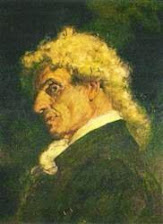Giuseppe Tartini, violinist and baroque composer, author of about 135 violin concertos and about 200 sonatas, is today known and remembered mainly for one sonata for violin and basso continuo, in G minor. Rather, for the sonata's last section, which incorporates a famous trill, popularly called "the devil's trill", a nickname originated in a legend that, allegedly, Tartini himself was responsible for forging and spreading.
Early years
Born in 1692 in Piran, then a city of the Republic of Venice, today part of Slovenia, being very young he was sent by his parents to follow the ecclesiastical career in a monastery. As soon as he could, however, he dropped out to enroll in the university of Padua to pursue studies of law and music, where he ended up being very popular as a swordsman. He married in 1710 a young girl somewhat younger who turned out to be the favorite of the bishop of Padua, who accused him of abduction, forcing him to hide in a convent.
It was there that he learned to play the violin.
 |
| Giuseppe Tartini (1602 - 1770) |
Exceptionally gifted for the instrument, in 1720 he assumed the position of principal violinist and chapel master of the Basilica of St. Anthony in Padua, and over the years he gained a wide and widespread reputation as one of the most notable violinists of the time. Retired in 1765, he remained at the basilica teaching until 1768, when a stroke left him severely disabled. He died in 1770, the same year as the birth of Beethoven eight months later.
Sonata for violin in G minor - "The Devil's trill"
As the astronomer Jerome Lalande tells in a travel book of 1765, Tartini himself would have told him about a dream he had while he remained hidden in the monastery, under the protection of the bishop:
“One night I dreamed I had made a pact with the devil for my soul. Everything went as I desired: my new servant anticipated my every wish. I had the idea of giving him my violin to see if he might play me some pretty tunes, but imagine my astonishment when I heard a sonata so unusual and so beautiful, performed with such mastery and intelligence, on a level I had never before conceived was possible. I was so overcome that I stopped breathing and woke up gasping. Immediately I seized my violin, hoping to recall some shred of what I had just heard; but in vain. The piece I then composed is without a doubt my best, and I still call it “The Devil’s Sonata,” but it falls so far short of the one that stunned me that I would have smashed my violin and given up music forever if I could but have possessed it.”
The sonata, published 28 years after Tartini's death, is in four movements. The last one contains the famously demanding passage (13:26) where the violinist trills while simultaneously playing arpeggiated triads.
The version offered here is for violin and piano. On violin, the South Korean artist Ko-Woon Yang. Her compatriot Chiharu Aizawa, at the piano.

No comments :
Post a Comment